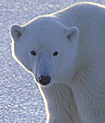An analysis of sequenced polar bear genomes provides new insights into how climate change and interbreeding with brown bears led to the evolution of the modern-day polar bear. In an analysis of the nuclear genomes of 28  brown, black, and polar bears, an international team of researchers found evidence that polar bear populations fluctuated with climate shifts over the last million years, with populations increasing during cooler periods and declining during periods of warmer temperatures. Their findings also suggest that during periods of glacial retreat, polar bears came into greater contact with brown bears as their ranges overlapped. “Maybe we’re seeing a hint that in really warm times, polar bears changed their life style and came into contact, and indeed interbred, with brown bears,” said Stephan Schuster, a scientist at Pennsylvania State University and co-lead author of the study, published in the Proceedings of the National Academy of Sciences. While earlier research indicated that polar bears have only existed for about 600,000 years, the new research suggests that the polar bear may have evolved into a distinct species 4 to 5 million years ago.
brown, black, and polar bears, an international team of researchers found evidence that polar bear populations fluctuated with climate shifts over the last million years, with populations increasing during cooler periods and declining during periods of warmer temperatures. Their findings also suggest that during periods of glacial retreat, polar bears came into greater contact with brown bears as their ranges overlapped. “Maybe we’re seeing a hint that in really warm times, polar bears changed their life style and came into contact, and indeed interbred, with brown bears,” said Stephan Schuster, a scientist at Pennsylvania State University and co-lead author of the study, published in the Proceedings of the National Academy of Sciences. While earlier research indicated that polar bears have only existed for about 600,000 years, the new research suggests that the polar bear may have evolved into a distinct species 4 to 5 million years ago.

Photo courtesy of Andrew Derocher